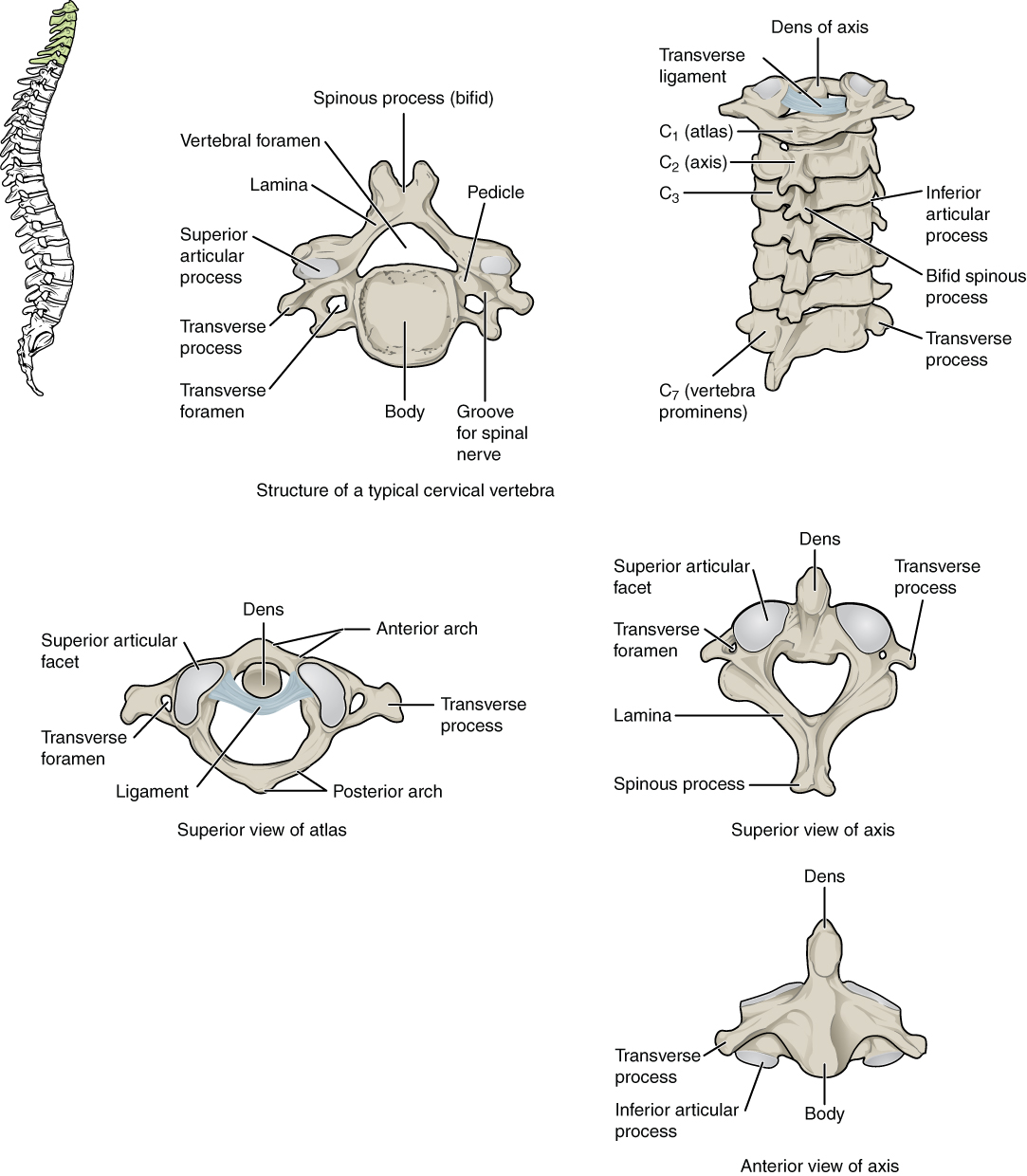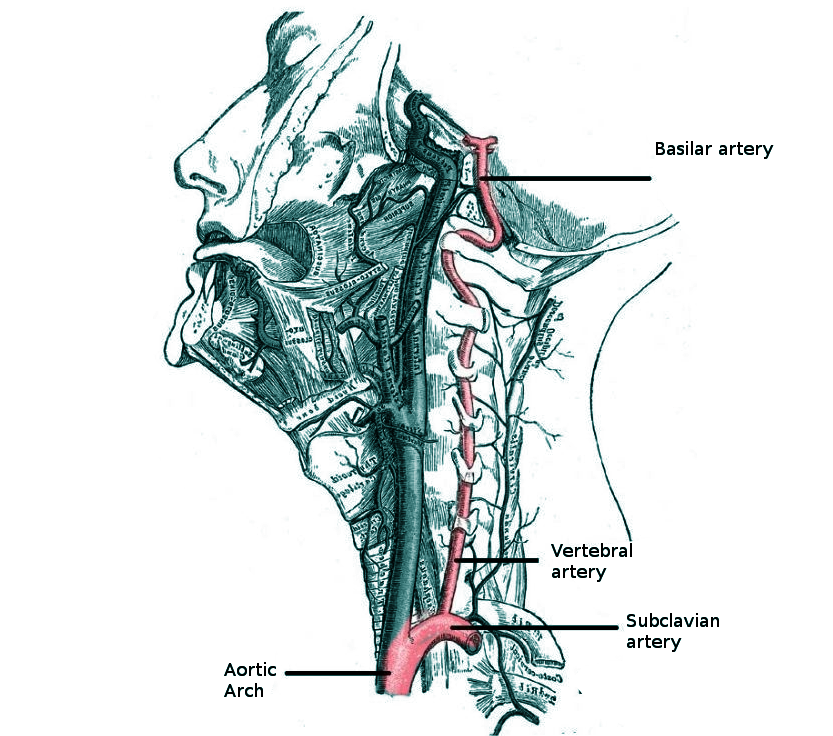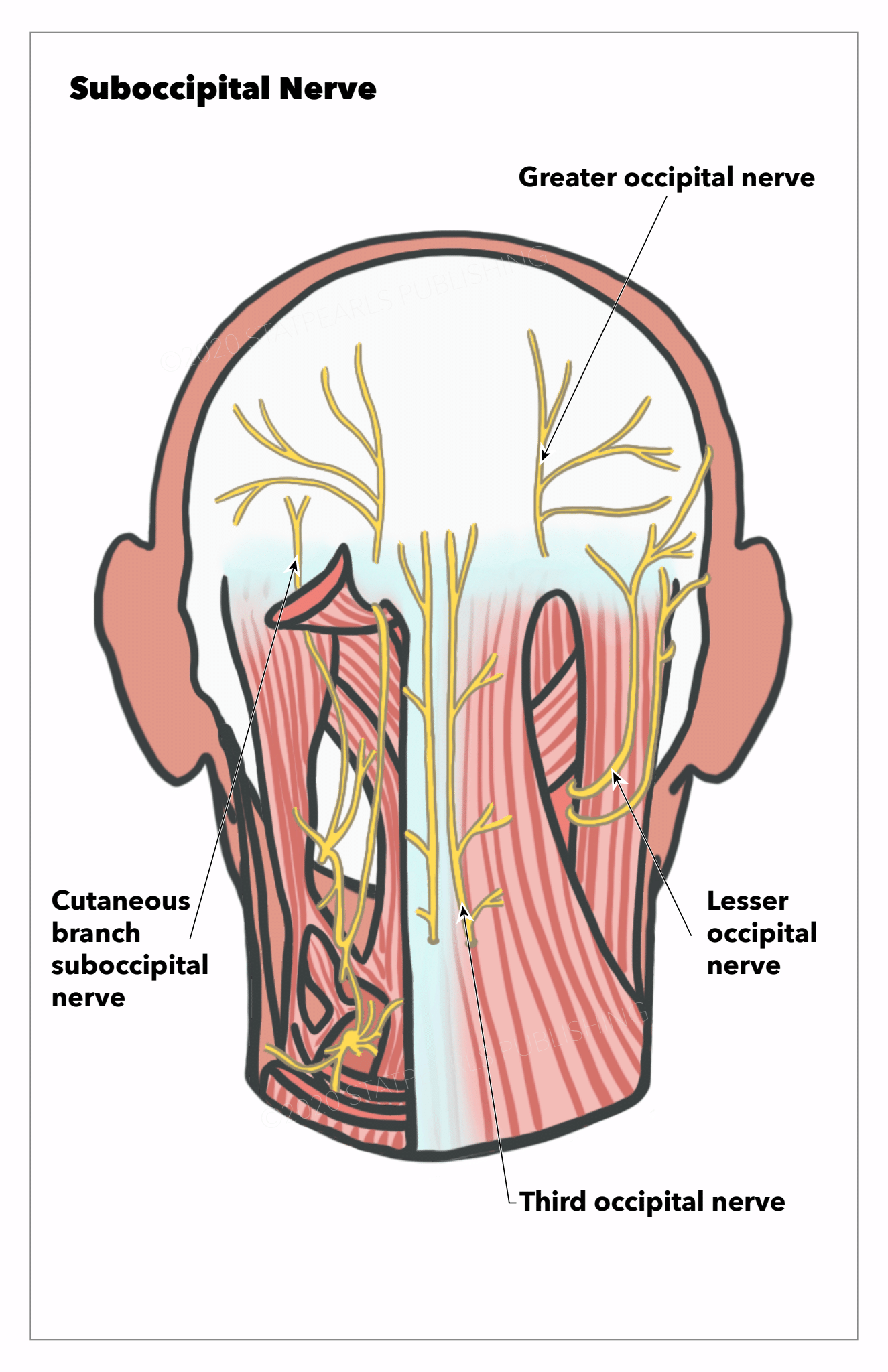[1]
Jenkins S, Iwanaga J, Dumont AS, Loukas M, Tubbs RS. What is the suboccipital nerve? Tracking this confusing historical nomenclature. Morphologie : bulletin de l'Association des anatomistes. 2021 Feb:105(348):10-14. doi: 10.1016/j.morpho.2020.09.002. Epub 2020 Nov 7
[PubMed PMID: 33172783]
[2]
Tubbs RS, Loukas M, Slappey JB, Shoja MM, Oakes WJ, Salter EG. Clinical anatomy of the C1 dorsal root, ganglion, and ramus: a review and anatomical study. Clinical anatomy (New York, N.Y.). 2007 Aug:20(6):624-7
[PubMed PMID: 17330847]
[3]
Gutierrez S, Huynh T, Iwanaga J, Dumont AS, Bui CJ, Tubbs RS. A Review of the History, Anatomy, and Development of the C1 Spinal Nerve. World neurosurgery. 2020 Mar:135():352-356. doi: 10.1016/j.wneu.2019.12.024. Epub 2019 Dec 12
[PubMed PMID: 31838236]
[4]
Tubbs RS, Loukas M, Yalçin B, Shoja MM, Cohen-Gadol AA. Classification and clinical anatomy of the first spinal nerve: surgical implications. Journal of neurosurgery. Spine. 2009 Apr:10(4):390-4. doi: 10.3171/2008.12.SPINE08661. Epub
[PubMed PMID: 19441999]
[5]
Giotta Lucifero A, Baldoncini M, Bruno N, Tartaglia N, Ambrosi A, Marseglia GL, Galzio R, Campero A, Hernesniemi J, Luzzi S. Microsurgical Neurovascular Anatomy of the Brain: The Posterior Circulation (Part II). Acta bio-medica : Atenei Parmensis. 2021 Aug 26:92(S4):e2021413. doi: 10.23750/abm.v92iS4.12119. Epub 2021 Aug 26
[PubMed PMID: 34437362]
[6]
Lake S, Iwanaga J, Oskouian RJ, Loukas M, Tubbs RS. A Case Report of an Enlarged Suboccipital Nerve with Cutaneous Branch. Cureus. 2018 Jul 6:10(7):e2933. doi: 10.7759/cureus.2933. Epub 2018 Jul 6
[PubMed PMID: 30202665]
Level 3 (low-level) evidence
[7]
Bogduk N. Functional anatomy of the spine. Handbook of clinical neurology. 2016:136():675-88. doi: 10.1016/B978-0-444-53486-6.00032-6. Epub
[PubMed PMID: 27430435]
[8]
Tubbs RS, Mortazavi MM, Loukas M, D'Antoni AV, Shoja MM, Cohen-Gadol AA. Cruveilhier plexus: an anatomical study and a potential cause of failed treatments for occipital neuralgia and muscular and facet denervation procedures. Journal of neurosurgery. 2011 Nov:115(5):929-33. doi: 10.3171/2011.5.JNS102058. Epub 2011 Jun 17
[PubMed PMID: 21682566]
[9]
Offiah CE, Day E. The craniocervical junction: embryology, anatomy, biomechanics and imaging in blunt trauma. Insights into imaging. 2017 Feb:8(1):29-47. doi: 10.1007/s13244-016-0530-5. Epub 2016 Nov 4
[PubMed PMID: 27815845]
[10]
Hovorka MS, Uray NJ. Microscopic clusters of sensory neurons in C1 spinal nerve roots and in the C1 level of the spinal accessory nerve in adult humans. Anatomical record (Hoboken, N.J. : 2007). 2013 Oct:296(10):1588-93. doi: 10.1002/ar.22757. Epub 2013 Aug 9
[PubMed PMID: 23929774]
[11]
Torun Bİ, Kendir S, Filgueira L, Shane Tubbs R, Uz A. Morphological characteristics of the posterior neck muscles and anatomical landmarks for botulinum toxin injections. Surgical and radiologic anatomy : SRA. 2021 Aug:43(8):1235-1242. doi: 10.1007/s00276-021-02745-2. Epub 2021 Apr 13
[PubMed PMID: 33847773]
[12]
Scherer SS, Schiraldi L, Sapino G, Cambiaso-Daniel J, Gualdi A, Peled ZM, Hagan R, Pietramaggiori G. The Greater Occipital Nerve and Obliquus Capitis Inferior Muscle: Anatomical Interactions and Implications for Occipital Pain Syndromes. Plastic and reconstructive surgery. 2019 Sep:144(3):730-736. doi: 10.1097/PRS.0000000000005945. Epub
[PubMed PMID: 31461039]
[13]
Takebe K, Vitti M, Basmajian JV. The functions of semispinalis capitis and splenius capitis muscles: an electromyographic study. The Anatomical record. 1974 Aug:179(4):477-80
[PubMed PMID: 4842939]
[14]
Choque-Velasquez J, Hernesniemi J. One burr-hole craniotomy: Suboccipital midline approach to the fourth ventricle in Helsinki neurosurgery. Surgical neurology international. 2018:9():170. doi: 10.4103/sni.sni_194_18. Epub 2018 Aug 22
[PubMed PMID: 30210903]
[15]
Choi I, Jeon SR. Neuralgias of the Head: Occipital Neuralgia. Journal of Korean medical science. 2016 Apr:31(4):479-88. doi: 10.3346/jkms.2016.31.4.479. Epub 2016 Mar 9
[PubMed PMID: 27051229]
[16]
Cesmebasi A, Muhleman MA, Hulsberg P, Gielecki J, Matusz P, Tubbs RS, Loukas M. Occipital neuralgia: anatomic considerations. Clinical anatomy (New York, N.Y.). 2015 Jan:28(1):101-8. doi: 10.1002/ca.22468. Epub 2014 Sep 22
[PubMed PMID: 25244129]
[17]
Bogduk N. The anatomical basis for cervicogenic headache. Journal of manipulative and physiological therapeutics. 1992 Jan:15(1):67-70
[PubMed PMID: 1740655]
[18]
Bogduk N, Govind J. Cervicogenic headache: an assessment of the evidence on clinical diagnosis, invasive tests, and treatment. The Lancet. Neurology. 2009 Oct:8(10):959-68. doi: 10.1016/S1474-4422(09)70209-1. Epub
[PubMed PMID: 19747657]
[19]
Grgić V. [Cervicogenic headache: etiopathogenesis, characteristics, diagnosis, differential diagnosis and therapy]. Lijecnicki vjesnik. 2007 Jun-Jul:129(6-7):230-6
[PubMed PMID: 18018715]
[20]
Baek IC, Park K, Kim TL, O J, Yang HM, Kim SH. Comparing the injectate spread and nerve involvement between different injectate volumes for ultrasound-guided greater occipital nerve block at the C2 level: a cadaveric evaluation. Journal of pain research. 2018:11():2033-2038
[PubMed PMID: 30310307]
[21]
Ljubisavljevic S, Zidverc Trajkovic J. Cluster headache: pathophysiology, diagnosis and treatment. Journal of neurology. 2019 May:266(5):1059-1066. doi: 10.1007/s00415-018-9007-4. Epub 2018 Aug 17
[PubMed PMID: 30120560]
[22]
Lambru G, Abu Bakar N, Stahlhut L, McCulloch S, Miller S, Shanahan P, Matharu MS. Greater occipital nerve blocks in chronic cluster headache: a prospective open-label study. European journal of neurology. 2014 Feb:21(2):338-43. doi: 10.1111/ene.12321. Epub 2013 Dec 7
[PubMed PMID: 24313966]
[23]
Rozen TD. High-Volume Anesthetic Suboccipital Nerve Blocks for Treatment Refractory Chronic Cluster Headache With Long-Term Efficacy Data: An Observational Case Series Study. Headache. 2019 Jan:59(1):56-62. doi: 10.1111/head.13394. Epub 2018 Aug 24
[PubMed PMID: 30144049]
Level 2 (mid-level) evidence
[24]
Thew M, Paech MJ. Management of postdural puncture headache in the obstetric patient. Current opinion in anaesthesiology. 2008 Jun:21(3):288-92. doi: 10.1097/ACO.0b013e3282f8e21a. Epub
[PubMed PMID: 18458543]
Level 3 (low-level) evidence
[25]
Girma T, Mergia G, Tadesse M, Assen S. Incidence and associated factors of post dural puncture headache in cesarean section done under spinal anesthesia 2021 institutional based prospective single-armed cohort study. Annals of medicine and surgery (2012). 2022 Jun:78():103729. doi: 10.1016/j.amsu.2022.103729. Epub 2022 May 7
[PubMed PMID: 35600186]
[26]
Malhotra S. All patients with a postdural puncture headache should receive an epidural blood patch. International journal of obstetric anesthesia. 2014 May:23(2):168-70. doi: 10.1016/j.ijoa.2014.01.001. Epub 2014 Jan 18
[PubMed PMID: 24656528]
[27]
Abdelraouf M, Salah M, Waheb M, Elshall A. Suboccipital Muscles Injection for Management of Post-Dural Puncture Headache After Cesarean Delivery: A Randomized-Controlled Trial. Open access Macedonian journal of medical sciences. 2019 Feb 28:7(4):549-552. doi: 10.3889/oamjms.2019.105. Epub 2019 Feb 19
[PubMed PMID: 30894910]
Level 1 (high-level) evidence
[28]
Hack GD, Koritzer RT, Robinson WL, Hallgren RC, Greenman PE. Anatomic relation between the rectus capitis posterior minor muscle and the dura mater. Spine. 1995 Dec 1:20(23):2484-6
[PubMed PMID: 8610241]
[30]
Moraska AF, Schmiege SJ, Mann JD, Butryn N, Krutsch JP. Responsiveness of Myofascial Trigger Points to Single and Multiple Trigger Point Release Massages: A Randomized, Placebo Controlled Trial. American journal of physical medicine & rehabilitation. 2017 Sep:96(9):639-645. doi: 10.1097/PHM.0000000000000728. Epub
[PubMed PMID: 28248690]
Level 1 (high-level) evidence
[31]
Cohen SP. Epidemiology, diagnosis, and treatment of neck pain. Mayo Clinic proceedings. 2015 Feb:90(2):284-99. doi: 10.1016/j.mayocp.2014.09.008. Epub
[PubMed PMID: 25659245]




